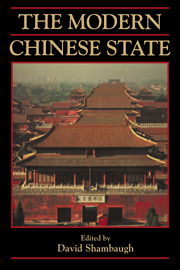Book contents
- Frontmatter
- Contents
- List of Contributors
- List of Illustrations
- List of Abbreviations
- Preface
- Introduction: The Evolving and Eclectic Modern Chinese State
- 1 The Late Imperial Chinese State
- 2 The Chinese State during the Republican Era
- 3 The Evolution of the State in the Republic of China on Taiwan
- 4 The Chinese State during the Maoist Era
- 5 The Chinese State in the Post-Mao Era
- 6 The Chinese Communist Economic State in Comparative Perspective
- 7 The Future of the Chinese State
- Index
6 - The Chinese Communist Economic State in Comparative Perspective
Published online by Cambridge University Press: 15 October 2009
- Frontmatter
- Contents
- List of Contributors
- List of Illustrations
- List of Abbreviations
- Preface
- Introduction: The Evolving and Eclectic Modern Chinese State
- 1 The Late Imperial Chinese State
- 2 The Chinese State during the Republican Era
- 3 The Evolution of the State in the Republic of China on Taiwan
- 4 The Chinese State during the Maoist Era
- 5 The Chinese State in the Post-Mao Era
- 6 The Chinese Communist Economic State in Comparative Perspective
- 7 The Future of the Chinese State
- Index
Summary
The aim of the communism that was implemented over vast areas of the world in this century (the real thing, not intellectual or salon communism) was to bring about a seamless unity of the state's official belief system, state monopoly of political and military power, stateprescribed social norms and relations, state-defined culture, and, importantly, state ownership, control, and management of the economy – in short, to bring into being a monolithic totalitarian state: allembracing and omnipotent, a oneness of state and society. Allowing for temporal, regional, and national variations, the institutions of the state itself (party, government, police, the judiciary, the military, mass organizations, economic planning apparatus) were highly hierarchical, commandist, centralized, pervasive, and pathogenically bureaucratized.
The totalitarian ideal was never fully attained – in China especially, localism continued to exert its traditional influence – but most variants of real socialism came very close to it at one time or another, in some instances over extended periods. To gain total control of the economy, which is what concerns us here, the communist state in almost every case had to tackle a double task: physical rebuilding of an economy ravaged by war and/or civil conflict and a restructuring (reform) from first principles of key economic institutions, primarily of the mechanism of allocation and coordination, and the system of property rights. In almost every case the first task proved to have been the easier of the two.
- Type
- Chapter
- Information
- The Modern Chinese State , pp. 188 - 215Publisher: Cambridge University PressPrint publication year: 2000
- 2
- Cited by



